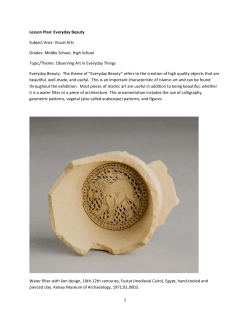
The Chemistry of Clay-Polymer Reactions
Soil interfaces for sustainable development Pre-Symposium Short Course: “The Chemistry of Clay-Polymer Reactions” By Benny K.G. Theng Landcare Research, Palmerston North, New Zealand Date: 4 and 5 July 2015 Location: To be announced Registration Fee: 250 $ (Canadian Dollars) Registration deadline: 30 April 2015 Abstracts Lecture 1 In this opening lecture we describe the basic structures, compositions and surface chemical properties of clay minerals. In terms of the clay-polymer interaction, montmorillonite is the most important mineral species because of its propensity for adsorbing and intercalating organic polymers. Kaolinite, halloysite, illite, palygorskite, sepiolite, allophane and imogolite are less frequently used than smectite. The same comment applies to vermiculite, mica and chlorite. Since the clay-polymer interaction commonly takes place in an aqueous medium, we also give a brief description of clay colloid chemistry. Here again, montmorillonite holds the limelight because of its capability for interlayer swelling and dispersibility in water. Lecture 2 This lecture discusses the theoretical and practical aspects of the clay-polymer interaction. Uncharged polymers adopt a ‘train-loop-tail’ surface conformation, giving high-affinity type isotherms and little desorption on dilution. The adsorption of non-ionic polymers is primarily driven by entropy effects. Positively charged polymers are strongly adsorbed through electrostatic interactions, causing chain collapse. Negatively charged polymers tend to be repelled by clay surfaces but can adsorb by bridging through polyvalent cations. The effect of adsorbed polymers on the structure of the electrical double layer, interparticle interaction, and flocculation is also described. Polymers can flocculate aqueous clay suspensions through charge neutralization and interparticle bridging. Lecture 3 This lecture summarizes the interactions of clay minerals with proteins and enzymes, including prion proteins and the layer-by-layer formation of clay-protein complexes. Proteins adsorb to clay surfaces through both enthalpic (electrostatic and van der Waals forces) and entropic (hydrophobic and conformational) interactions. Adsorption and intercalation by clay minerals cause conformational changes but no extensive unfolding of the polypeptide chains. Adsorption commonly reaches a maximum close to the protein isoelectric point. The pH- activity profile for adsorbed enzymes is often shifted to higher pH values, and the MichaelisMenten rate constant is enhanced as compared with the corresponding free enzymes. Clayimmobilized enzymes can detoxify some organic pollutants in soil. Lecture 4 Here we outline the interactions of clay minerals with nucleic acids. Adsorption of nucleic acids to clay minerals proceeds through electrostatic interactions, cation-bridging and ligand exchange. The latter bonding mode is important with kaolinite and allophane. Adsorption declines as solution pH increases from acid to alkaline but is enhanced in the presence of neutral electrolytes and polyvalent cations. Nucleic acids can intercalate into montmorillonite at pH < 6. Adsorption also leads to a change in molecular conformation. Clay-associated DNA may be amplified through the polymerase chain reaction and is capable of transforming competent cells. Montmorillonite can catalyse the formation of RNA from its activated monomers. Lecture 5 This lecture summarizes the interactions of clay minerals with viruses and bacteriophages. Below the isoelectric pH of the virus, adsorption to clay minerals is largely accomplished through electrostatic interactions. Above this pH, van der Waals interactions and entropy effects associated with conformational changes come into play. Cation-bridging and ligand exchange are also involved. The clay-virus interaction is enhanced in the presence of neutral electrolytes and polyvalent cations. Adsorption of viruses and bacteriophages is confined to external clay particle surfaces, even in the case of expanding layer silicates (montmorillonite) because the molecules are too large to penetrate the interlayer space. Lecture 6 Here we discuss the formation and properties of clay-polysaccharide complexes. Cationic and non-ionic polysaccharides are strongly adsorbed by clay minerals and can penetrate the interlayer space of montmorillonite. Anionic polysaccharides are weakly adsorbed and do not intercalate into montmorillonite although appreciable uptake can occur at acid pH, high ionic strength, and in the presence of polyvalent cations. All things being equal, polysaccharide adsorption to clay minerals decreases in the order cationic > non-ionic > anionic. Next to humic substances, polysaccharides and glomalin (a glycoprotein) are the most important aggregatestabilizing agents in soil but their effectiveness is relatively short-lived. Lecture 7 This lecture outlines the structural concepts of humic substances (HS) and their interactions with clay minerals through a variety of bonding modes. Complex formation between HS and clay minerals is influenced by the nature of exchangeable cations at the clay surface, medium pH and ionic strength, molecular weight of HS and clay mineral species. Humic substances generally fail to intercalate into montmorillonite but can do so under highly acidic conditions when the molecules are essentially uncharged. In soil, HS may aid mineral decomposition and metal ion mobilization, while clay-humic complexes are good sorbents of metal ions and nonionic organic compounds and pollutants.
© Copyright 2025












